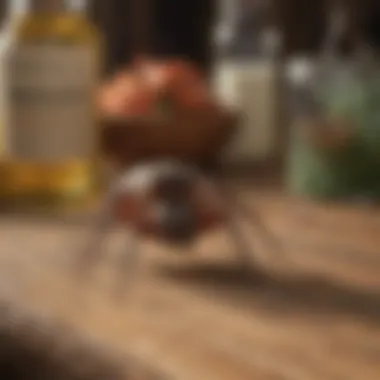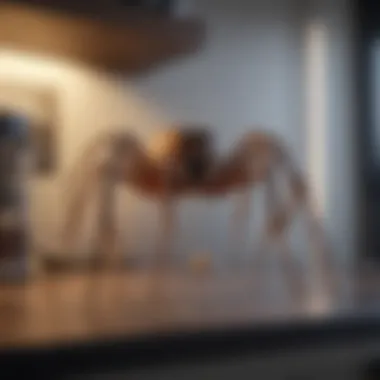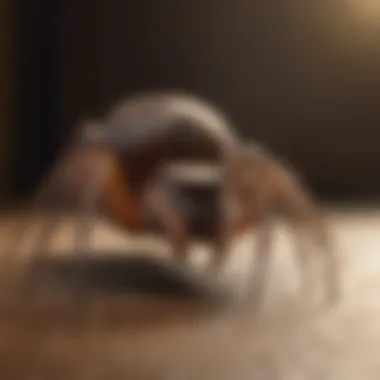Effective Strategies for Eliminating House Spiders


Intro
Managing house spiders is not just a matter of aesthetics; it is essential for maintaining a comfortable and healthy living environment. Their presence often incites unease, prompting homeowners to seek effective ways to manage these arachnids. Spiders play a role in the ecosystem by controlling pest populations, yet their unwelcome intrusion into personal spaces can be bothersome. Understanding the nature of these creatures, their potential impact on the home, and how to address infestations through various means is crucial for effective management.
Pest Identification
Understanding what you are dealing with is the first step in eliminating house spiders. Different species inhabit homes, and recognizing their characteristics can assist in developing suitable responses to infestation.
Detailed descriptions of common pests
Common house spiders include the common house spider (Parasteatoda tepidariorum), identifiable by its brownish body and small size. Then there is the black widow (Latrodectus mactans), known for its glossy black body and the distinctive red hourglass shape on the underside of its abdomen. Another frequent visitor is the yellow sac spider (Cheiracanthium spp.), which is light yellow and often attacks at night. Each of these spiders exhibits unique behaviors and habitat preferences.
Signs and symptoms of infestations
Identifying a spider infestation involves recognizing their signs:
- Webs: The first and most obvious indication is the presence of webs. These can be fine and intricate or rough and irregular, depending on the species.
- Feces: Dark specks, tiny and pellet-like, are often found in areas frequented by spiders.
- Sightings: Spotting spiders themselves, particularly during the day when they typically hide, can signify an overpopulation.
"An early identification of spider species can determine the appropriate course of action for control and management."
Prevention Strategies
Preventing spider infestations is always preferable to treatment. Several home maintenance tips can significantly reduce the chances of encountering these pests.
Home maintenance tips for pest prevention
- Sealing Entry Points: Inspect doors, windows, and any cracks in walls or foundations. Use caulk or weather stripping to close gaps.
- Decluttering: Minimizing clutter in and around the house reduces hiding spots for spiders.
- Regular Cleaning: Vacuuming and dusting regularly helps remove webs and eggs, preventing potential new populations.
Natural deterrents and barriers
Natural deterrents can also aid in keeping spiders at bay. Consider:
- Essential Oils: Scents like peppermint and tea tree oil can deter spiders. Mix with water and spray in areas prone to spider activity.
- Diatomaceous Earth: Sprinkling this natural powder around the home can dehydrate and kill spiders upon contact.
Treatment Options
When preventive measures fail, various treatment options can help in managing existing populations of house spiders.
Overview of chemical vs. natural treatments
Understanding the difference between chemical and natural treatments can help homeowners choose the best route for their situation. Chemical sprays can provide immediate relief but often come with health and environmental concerns. Natural treatments may take longer to work but are generally safer and more eco-friendly.
Step-by-step guides for DIY treatments
For those opting for a DIY approach, here are simple methods to manage spiders:
- Essential Oil Spray: Combine 10-15 drops of peppermint oil with water in a spray bottle. Shake well and apply in spider-prone areas.
- Diatomaceous Earth Application: Lightly sprinkle diatomaceous earth in corners and along baseboards. Ensure pets and children stay away until cleared.
- Soap and Water Solution: Mix dish soap with water in a spray bottle. Use this solution to target spiders directly.
Understanding House Spiders
Understanding house spiders is a vital part of creating a spider-free home. This section lays the groundwork for recognizing the various aspects of house spiders, which in turn aids in more effective elimination and management efforts. By delving into the types of spiders typically found in homes, their behaviors, and reproduction methods, homeowners can adopt strategies that are targeted and practical.
Common Species Found in Homes
Many homeowners might be surprised to learn that several spider species commonly inhabit residential spaces. Here are a few notable examples:
- Common House Spider: This spider is often identified by its pale yellow to brown color. It is usually found in corners and crevices of rooms.
- Wolf Spider: A larger spider known for its agility. It does not spin webs but often takes shelter under furniture or in basements.
- Black Widow: Recognizable by the distinctive hourglass marking on its abdomen. This species is less common but is feared due to its venom potency.
Identifying these species is crucial as it informs the appropriate removal methods. Knowing their tendencies will also contribute to effective prevention strategies.
Behavior and Habitat Preferences
House spiders exhibit specific behavioral traits that help them survive in human environments. They prefer dimly lit areas, often going undetected. In general, spiders choose locations that provide both shelter and access to food sources, such as other insects.


Common habitats within houses include:
- Basements and cellars: These areas are often damp and secluded, making them favorable for spider habitation.
- Attics: Infrequently accessed spaces can become the perfect spots for webs.
- Corners of rooms: Spiders tend to weave webs in quiet, unreachable places, typically in corners where dust accumulates.
Their nocturnal nature further complicates detection, as they are more active at night. Understanding these behavioral patterns is essential to disrupt their life cycle effectively.
Life Cycle and Reproduction
The life cycle of house spiders typically consists of three stages: egg, spiderling, and adult. Female spiders produce egg sacs that can hold hundreds of eggs. Depending on the species, it may take a few weeks to months for the eggs to hatch.
Once hatched, spiderlings will eventually disperse, seeking their own environments that meet their needs for food and shelter. This reproductive cycle can lead to sudden increases in spider populations if not managed.
Knowing this cycle allows homeowners to implement preventative measures before infestations escalate.
"Understanding their life cycle can be the key to preventing future infestations.”
Identifying Infestations
Identifying spider infestations in your home is a crucial step in effective spider management. Understanding the signs and locations commonly associated with these creatures can help homeowners take timely action. By being proactive, you can minimize the risk of an infestation gaining ground, thus maintaining a more pleasant living environment.
Signs of Spider Presence
Several indicators can signal the presence of spiders in your home. Observing these signs early can help in controlling their population. Common signs include:
- Webs: The most obvious sign, spider webs can often be found in corners of rooms, ceilings, and near windows. Their texture and design can vary, indicating different species.
- Egg Sacs: Finding egg sacs is a strong indicator of a potential spider population. These sacs can often be small and may resemble little cotton balls or small bags.
- Shedding Skins: Spiders shed their skins as they grow. Finding these can mean that there are spiders living near.
- Sightings: Simply spotting a spider is often the first sign. It can be beneficial to note how many spiders you see and where they appear most frequently.
When at least some of these signs are present, it may confirm the need for further inspection.
Common Hiding Spots in Homes
Spiders typically seek out safe, undisturbed areas within a home to nest. Awareness of these common hiding spots can aid in identifying where to look for infestations. The following areas are the most likely to harbor spiders:
- Basements and Cellars: These dark, damp environments provide ample coverage. They are often ideal for spiders.
- Attics: Like basements, attics are usually less disturbed. Dusty corners and beams are prime locations.
- Behind Furniture: Move furniture occasionally to check behind and underneath for webs or spiders.
- Under Appliances: Ovens, refrigerators, and dishwashers may not be cleaned regularly, offering a cozy refuge for spiders.
- Webs in Corners: Corners of rooms and window frames are typical spider locales where they can easily spin webs.
Being vigilant in these areas can assist with spotting an infestation before it escalates. Knowledge about these signs and hiding spots lays a foundation for effective action against house spiders.
Preventive Measures
Preventive measures are essential for minimizing the presence of house spiders. Effective prevention involves understanding how spiders enter homes and what attracts them. By addressing these factors, homeowners can significantly reduce the likelihood of infestations. The advantages of implementing preventive measures include not only a decrease in spider populations but also a more hygienic living environment. Additionally, prevention often requires less time and expense compared to combating an established infestation.
Sealing Entry Points
One of the first lines of defense against house spiders is sealing potential entry points. Spiders can enter through tiny gaps and cracks around windows, doors, and foundational areas. Inspecting the exterior of your home for these vulnerabilities is crucial. Use caulk or weather stripping to seal gaps around windows and doors. Pay special attention to utility lines or other openings where spiders may find easy access to your living space. Blocking these points greatly reduces the possibility of spider intrusion.
Maintaining Cleanliness
Another effective preventive measure involves keeping a clean environment. Regular cleaning routines help eliminate spider food sources such as insects and webs. It is important to vacuum carpets, curtains, and under furniture frequently. Sweeping and mopping floors can also remove potential spider nests and egg sacs.
Decluttering rooms is another critical step. Spiders often hide in piles of clothing, boxes, or other forgotten items. Organizing storage areas and discarding unnecessary items not only helps prevent spiders but also contributes to a more organized living space.
Utilizing Natural Repellents
Natural repellents can deter spiders and minimize their presence without the need for harsh chemicals.
Essential Oils
Essential oils have gained attention for their potential in repelling spiders. Oils like peppermint, tea tree, and lavender are considered effective. Their strong scents often deter not only spiders but also their prey. Peppermint oil is particularly popular due to its intense aroma and its capability to mask other smells that attract spiders. However, while essential oils can be beneficial, they require regular reapplication after cleaning or if the scent fades. Homeowners should test oils in small areas first, as some pets may be sensitive to certain concentrations.
Citrus Peels
Citrus peels, especially from lemons and oranges, are another natural option. The strong scent of citrus acts as a repellent, disrupting spiders’ navigation abilities. This method is both eco-friendly and inexpensive, making it a favorable choice for many households. A unique feature of citrus peels is that they are biodegradable, reducing waste. However, the effectiveness of citrus peels can fade over time, necessitating regular replacement to ensure they remain a deterrent.
By taking smart preventive measures, you can create an environment that is much less inviting for house spiders.


Chemical Solutions
Chemical solutions play a crucial role in the management and elimination of house spiders. While ensuring a spider-free environment sometimes demands preventive measures and eco-friendly options, there are scenarios where chemical solutions are necessary. These solutions can effectively reduce spider populations, particularly when infestations are more severe. Understanding the various insecticides available and their proper applications can significantly improve the chances of achieving a spider-free home.
Insecticides for Indoor Use
Insecticides formulated for indoor use are specifically designed to target pests like spiders without posing significant risks to humans and pets. Common active ingredients include pyrethrins, permethrin, and bifenthrin. Each of these compounds has distinct modes of action against spiders. For instance, pyrethrins quickly affect the nervous system, causing paralysis in spiders upon contact.
When selecting insecticides, consider products that come in ready-to-use sprays or powders. These forms often make applications easier, especially in common hideouts such as corners, behind furniture, or under sinks. However, always follow the manufacturer's instructions for effective results. Some preferred products include:
- Raid Spider Killer
- Ortho Home Defense Insect Killer
- Hot Shot Bed Bug and Flea Killer
Another important aspect is the formulation type – residual insecticides provide longer-lasting effects compared to non-residual varieties. While applying, it is prudent to target areas where spiders frequent rather than generalized spraying to minimize unnecessary exposure to chemicals.
Safety Precautions When Using Chemicals
The application of insecticides must be approached with caution. Potential health risks may arise from improper handling. Here are essential safety precautions to consider:
- Read Labels Carefully: Always read and follow product labels, as they contain vital information on proper use and precautions.
- Protective Gear: When spraying insecticides, wear gloves and a mask to minimize skin contact and inhalation risks.
- Ventilation: Ensure sufficient ventilation in the area where insecticides are used. Open windows and doors during and after application can help reduce exposure.
- Keep Pets and Children Safe: Remove pets and children from the treated area until it is safe to return, as stated on the product label.
- Storage: Store chemicals in secure locations out of reach of children and pets. Always follow disposal guidelines to reduce environmental impact.
Employing these safety measures helps mitigate risks associated with chemical pest control while maximizing efficacy.
"A proper understanding of the product will result in better effectiveness while ensuring safety."
In summary, chemical solutions are effective when used responsibly. By choosing the right insecticides and adhering to safety protocols, homeowners can tackle spider issues effectively without compromising their family's health.
Natural and Eco-Friendly Methods
Natural and eco-friendly methods of managing house spiders offer sustainable alternatives to chemical solutions. These approaches are increasingly relevant as homeowners seek to minimize their environmental impact while effectively controlling pest populations. By utilizing substances that are generally safe for both humans and pets, homeowners can achieve better peace of mind while tackling the issue at hand.
Eco-friendly solutions are particularly important because they protect not only the immediate household environment but also the broader ecosystem. Many of the chemicals used in traditional pest control are harmful to beneficial insects and can contribute to pollution. Natural methods often present effective ways to deter spiders without introducing toxic substances into living spaces.
When exploring these methods, it is crucial to consider both efficiency and safety. Homeowners should take time to learn about the various options available, assessing their suitability for their unique living situations. This understanding can ultimately facilitate a more informed and responsible approach to pest management, fostering both comfort and ecological mindfulness.
Diatomaceous Earth
Diatomaceous earth is a natural powder made from the fossilized remains of tiny aquatic organisms known as diatoms. Its unique composition allows it to be an effective barrier against spiders and other crawling pests. When sprinkled in areas where spiders are often found, this abrasive powder can damage the exoskeleton of insects, leading to dehydration and death.
- Application: To use diatomaceous earth effectively, apply a thin layer in corners, along baseboards, and in other known spider hotspots. It's crucial to ensure that it remains dry, as moisture reduces its effectiveness.
- Natural Composition: This product is non-toxic to humans and pets, making it a popular choice for households with children or animals. However, homeowners should still avoid inhaling the dust, as it may irritate the lungs.
Diatomaceous earth serves not only to control spiders but also prevents the potential risk of infestation by other pests as well. Regular monitoring and reapplication will ensure that its presence continues to deter unwanted critters.
Vinegar-Based Solutions
Vinegar solutions are another excellent eco-friendly approach to managing spider populations. The strong smell of vinegar serves as a potent repellent. White vinegar, particularly, can effectively discourage spiders from entering a home or settling in certain areas.
- Recipe: A simple mixture consists of equal parts water and white vinegar. This solution can be sprayed in areas where spiders are commonly seen.
- Usage: Focus on entry points, window sills, and corners of rooms. The strong odor not only repels spiders but also helps clean surfaces, leaving homes fresh.
While vinegar is effective, it may not eliminate spiders entirely. Rather, it serves as a deterrent and should be part of a broader strategy that includes cleaning and other preventive measures. Each application will need to be repeated regularly for sustained effectiveness.
"Using natural and eco-friendly methods is a fundamental step towards creating a long-term strategy for spider elimination that prioritizes both health and safety."
Long-Term Management Strategies
Long-term management strategies are crucial in maintaining a spider-free household. An effective approach goes beyond mere elimination and focuses on consistent preventive measures. This ensures that once spiders are removed, they do not return. Additionally, it provides homeowners with a systematic way to create a less welcoming environment for these pests.
When it comes to managing house spiders, understanding the lifespan and habits of these creatures plays a key role. Spiders tend to build webs in secluded areas, and if left unchecked, their populations can grow quickly. Therefore, regular care and attention are necessary to disrupt their life cycle and habitat preferences. Moreover, long-term strategies help in reducing the reliance on chemical solutions, contributing to a healthier living space for both people and pets.
Routine Cleaning Practices
Practicing routine cleaning is essential in long-term spider management. Regularly dusting corners, vacuuming floors, and clearing debris can significantly reduce potential habitats for spiders. Pay extra attention to less visible areas such as behind furniture, in basements, and in attics.
- Dusting: Use a duster with an extendable handle to reach high corners and ceilings. This removes webs and eggs, preventing further infestations.
- Vacuuming: A vacuum can be your best tool. Make sure to regularly vacuum corners and under furniture to capture spiders and their webs.
- Decluttering: Reducing clutter minimizes available hiding spots for spiders. Store items in sealed boxes and maintain tidy spaces.


To enhance effectiveness, cleaning should be scheduled regularly, ideally on a weekly basis. Implementing these habits cultivates an environment where spiders are less likely to establish themselves.
Continuous Monitoring for Signs of Return
Monitoring is a vital aspect of long-term spider management. After implementing cleaning practices and removing spiders, it is essential to remain vigilant for signs of their return. Being proactive can allow early intervention and prevent larger infestations.
To effectively monitor your home for spiders, consider:
- Regular Inspections: Frequently check areas where spiders are known to reside. Look for new webs or sightings, and check the corners of rooms and attics.
- Documentation: Keep a log of any spider sightings or evidence of returning pests. This information helps identify patterns and enables you to take timely action.
- Engaging Family Members: Encourage all household members to report any signs of spiders. Collective vigilance creates a comprehensive monitoring approach.
When to Seek Professional Help
As homeowners confront the challenge of house spiders, understanding when it's appropriate to call a pest control professional is crucial. An infestation can become overwhelming and complex. Knowing the right time to seek expert help can protect your home, ensuring that you use resources effectively.
Indicators of a Severe Infestation
Detecting a severe spider infestation is not difficult if you know what to look for. Here are some key signs:
- Increased Spider Activity: If you notice more spiders in your home than usual, that could indicate a serious issue.
- Presence of Egg Sacs: Finding egg sacs is a clear sign the situation has escalated. Each sac can contain dozens of eggs that will soon hatch.
- Webs in Abundance: If your windows, corners, or other areas of your home are filled with webs, that is a definite red flag.
- Bite Marks or Allergic Reactions: If anyone in your household experiences bites or allergic reactions, this could be a sign of a more aggressive spider species.
Addressing these indicators swiftly is essential. Ignoring them can lead to exponential growth of spiders in your living space. Seeking professional assistance can lead to a swift and effective resolution, preventing further complications.
Choosing the Right Pest Control Service
Once you decide to call a professional, you must choose the right pest control service. Not all services are equal, and some may not specialize in spiders. Keep these points in mind:
- Look for Specialization: Choose a service with experience in handling spider infestations specifically.
- Check Reviews and Recommendations: Look for reviews online on platforms like Reddit or local forums. Recommendations from friends also help establish trust.
- Ask About Their Methods: Understand whether they use chemical solutions or eco-friendly options. This is especially important if you have children or pets.
- Request an Inspection: A reputable service will often conduct an inspection first. This helps them tailor their approach to your specific situation.
Debunking Common Myths About House Spiders
Understanding the myths surrounding house spiders is crucial for any homeowner. In many cases, misconceptions cause unnecessary fear and promote harmful actions. By addressing these common myths, individuals can approach spider management more rationally. Education is key, as it not only helps in reducing anxiety but also informs effective strategies to prevent and control spider populations. Below are two significant misconceptions that need clarification.
Misconceptions About Spider Venom
There is a widespread belief that all spiders are highly venomous and pose a significant health threat. In reality, the vast majority of house spiders possess venom that is not dangerous to humans. Only a few species, like the black widow or brown recluse, have venom potent enough to cause serious harm. The venom is primarily used to subdue their prey, which usually consists of insects. To view spiders simply as venomous creatures neglects their role and can lead to exaggerated responses when encountering them.
It's essential for homeowners to understand that the risk of a serious spider bite is minimal. Simple precautions such as wearing gloves when handling garden materials or cleaning basements can mitigate any potential danger.
The Role of Spiders in the Ecosystem
Another common myth is that spiders are detrimental to domestic environments. This perception leads to many homeowners seeking aggressive elimination methods. However, spiders play a significant role within ecosystems. They are natural predators, controlling populations of various pests such as flies, mosquitoes, and other insects.
A balanced ecosystem within the home will actually benefit from having spiders around. Here are some points to consider:
- Natural Pest Control: Spiders help keep other insect populations in check, reducing the need for chemical pesticides.
- Biodiversity: By coexisting with spiders, homeowners promote biodiversity, which is beneficial for the overall health of their local environment.
"Spiders can offer a form of biological pest control, often making your home less hospitable to other unwanted insects."
Finale
Understanding the significance of effective strategies for eliminating house spiders is essential for maintaining a comfortable and safe living environment. The presence of spiders in a home often raises concerns, mainly due to misconceptions surrounding their behavior and the potential threat they pose. In this article, we have explored various methods to address spider infestations, from preventive measures to eco-friendly treatments and chemical solutions.
The benefits of implementing these strategies are twofold. First, they provide homeowners with the knowledge necessary to manage spider populations without incurring significant costs or resorting to professional pest control services unless necessary. Second, by understanding the ecological role that spiders play, homeowners can appreciate their presence, striking a balance between eradication and coexistence.
When considering the best approaches to control spiders, factors such as safety, environmental impact, and long-term effectiveness all play a critical role. Homeowners must assess their specific situations to determine which methods are most suitable for their circumstances. By embracing a comprehensive approach that includes cleanliness, sealing entry points, and appropriate treatment options, households can effectively reduce spider populations while preserving their homes' integrity.
Summary of Effective Strategies
To recap the effective strategies discussed in this article:
- Preventive Measures: Regular cleaning and sealing possible entry points are crucial steps to avoid unwanted spider activity. Employing natural repellents like essential oils and citrus peels also minimizes their presence without chemical intervention.
- Chemical Solutions: For immediate relief, appropriately chosen insecticides can be employed. Homeowners must prioritize safety by understanding the active ingredients and following application guidelines precisely.
- Natural Methods: Solutions such as diatomaceous earth and vinegar-based sprays offer eco-friendly alternatives that can effectively deter spiders without harmful chemicals.
- Long-Term Management: Establishing routine cleaning practices and continuously monitoring potential spider activity can help prevent future infestations. This vigilance is essential for maintaining a spider-free home.
Final Thoughts on Spider Management
It is important to remember, though, that every home is unique. The strategies that work for one household may need adjustment for another, making flexibility and observation key components of success. Encouraging an informed, proactive mindset empowers homeowners to take charge of their spaces, ensuring not only a clean and safe living area but also a deeper appreciation for the ecological web we are all part of.
"House spiders are not only a nuisance but play a significant role in controlling household pest populations. Targeted management is crucial."
Incorporating the insights provided in this article can lead to a healthier home environment and a more informed relationship with the natural world that exists alongside us.



